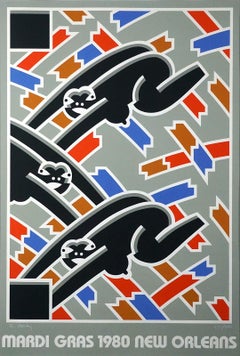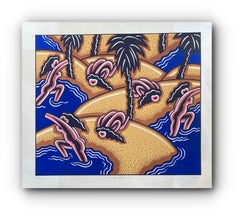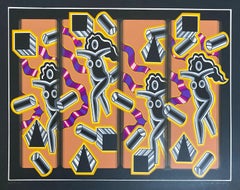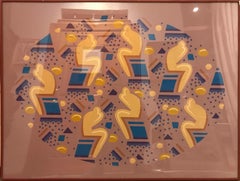Robert Gordy Abstract Prints
Robert Gordy was an iconic New Orleans painter. He was part of the Art and Decoration movement that also included Keith Haring. Balancing a clean, formal graphic approach with creativity, wit and verve, Gordy created a style of painting that is instantly recognizable to anyone even vaguely familiar with his work. Sometimes placed in a category with Keith Haring, he created images that exploited patterns and simplicity of form. He had a wonderful sense of color as well. Gordy’s art-making was unusual in his frequent use of markers, pens and ink to create his images – which are so clean that they look to a contemporary eye to be machine or computer-created. He was enraptured with print-making and produced much limited-edition print series. Robert Gordy’s works are in museums worldwide, including the Whitney, MoMA, the Smithsonian Institution and other top-tier institutions.
20th Century Abstract Geometric Robert Gordy Abstract Prints
Screen
1980s Abstract Robert Gordy Abstract Prints
Screen
1980s Abstract Robert Gordy Abstract Prints
Screen
1980s Abstract Robert Gordy Abstract Prints
Screen
1970s Abstract Robert Gordy Abstract Prints
Lithograph
1970s Abstract Robert Gordy Abstract Prints
Lithograph
1970s Abstract Robert Gordy Abstract Prints
Lithograph
Mid-20th Century Cubist Robert Gordy Abstract Prints
Screen
1960s Robert Gordy Abstract Prints
Lithograph
1970s Pop Art Robert Gordy Abstract Prints
Screen, Paper
Late 20th Century Abstract Robert Gordy Abstract Prints
Paper, Ink, Screen
1970s Abstract Robert Gordy Abstract Prints
Paper, Screen
1990s Abstract Robert Gordy Abstract Prints
Screen
Mid-20th Century Abstract Robert Gordy Abstract Prints
Lithograph
1990s Abstract Geometric Robert Gordy Abstract Prints
Screen
1970s Abstract Expressionist Robert Gordy Abstract Prints
Screen



